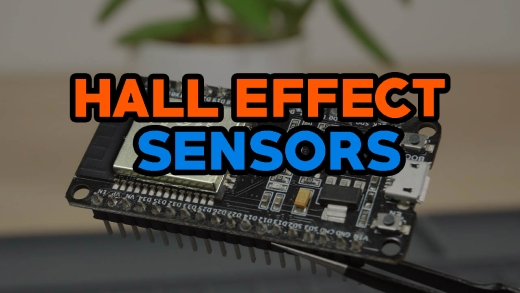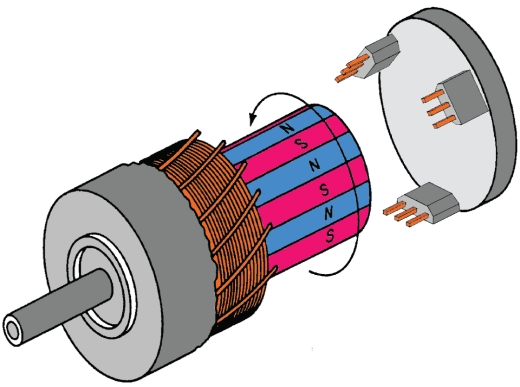Hall Effect Sensors: Types and Applications

Hall Effect sensors can detect magnetic fields even though they are invisible to the human eye. They convert magnetic field changes into electrical signals by sensing changes in magnetic fields. Powerful, yet simple. Smartphones, industrial machines, and cars all use this technology. Our daily lives depend on them for measuring speed, position, and current. There are different types, each designed for a specific purpose. The motion of some is tracked. Currents are monitored by others. Magnets are detected by some devices simply by detecting their presence. What applications do they have? Infinite. The technology we use relies on them for everything from brakes to touchscreens.
What are Hall Effect Sensors?
Magnetic fields are detected by Hall Effect sensors. In order to make electrical signals, they take something invisible, magnetism, and turn it into a signal. The idea is simple, but it has a big impact. Sensors react when magnets come close. An electric charge is created. Using that voltage, we measure, process, and utilize it. It doesn't matter what the speed, the position, or the current is, Hall sensors track it all. There are a lot of them, but they're tiny. The screen on your phone, as well as the screens in cars and industrial machines.
What are their working principles? There's something called the Hall Effect at work here. Conductors that pass electricity through magnetic fields bend when they are exposed to them. As a result of that bending, voltage is created. Magnetism is more prevalent? Voltage is higher. Less? There is a drop in signal. It is for this reason that Hall sensors have a high level of reliability and precision. A non-moving part. Physics at its purest. It's for this reason that industries trust them. You can also check out: ACS712 Current Sensor.
Applications of Hall Effect Sensors

Automotive Industry
The way cars communicate is not through words, but through signals. It is possible for them to do this thanks to Hall Effect sensors. Their job is to make sure ABS brakes work correctly by tracking wheel speed. The vehicle does not skid or lock suddenly. The throttle sensor uses them as well. Fuel flow is immediately adjusted when the gas pedal is pressed. An acceleration that is smooth. Delays are not present. Hall technology is also used in fuel level sensors. There is no direct contact, so there is no wear and tear.
Industrial Machinery
There is no room for mistakes in factories. Smooth operation is essential for machines. In order to keep them in check, they are monitored by Hall Effect sensors. Robotic arms are monitored for accuracy, conveyor belts are tracked, and motor speeds are monitored. A misalignment? It is known to the sensor. It's time to send an alert before it's too late. Is there downtime? I don't think so. Sensors ensure that everything is running smoothly. There is no friction, so there is no wear. The monitoring must be constant and reliable.
Consumer Electronics
Make sure your laptop is closed. There is an automatic shutoff of the screen. Here's an example of a Hall sensor in action. Closed lids are detected by the device. You save power, and your work is protected. In addition to gaming controllers, they are used in video games. The traditional joystick wears out over time. Hall sensors? Contact is not made physically. There is no friction. Movement that is smooth and precise. What is the case on your phone? The same thing applies. Magnets lock the screen when they come close to it.
Medical Devices
It's all about accuracy. There is a possibility that one small mistake could lead to death in a hospital. There's no need to worry though, Hall sensors can help. Their job is to maintain the right rate of flow of medicine through infusion pumps. There is no need to guess. They are also used by MRI machines. Magnetic fields are tracked, resulting in crystal-clear images. There is even a need for them in prosthetics. Assists artificial limbs in moving naturally by sensing motion. If there are no moving parts, then there is no room for failure.
Power and Energy Sector
The power of electricity needs to be controlled. In high currents, things burnout, but in low currents, they are still functional. In the absence of sufficient energy, systems fail. There's no need to worry. A hall sensor fixes that problem. Power grids are monitored, overloads are detected, and circuits are kept safe by these professionals. They are also used by solar panels. Tracking the sun's position ensures every ray is counted. In addition, wind turbines are also used. A sensor tracks the rotor speed to ensure smooth power production.
Security Systems
Whenever doors are locked, alarms are triggered, and safes are closed. Hall sensors are responsible for all of this. A magnet can be detected when it moves out of place with the magnet detectors. What should you do if something shifts unpredictably? It is known to the system. It sends an alert. Furthermore, it is also used in magnetic key cards. Changing the field, unlocking the door, and swiping the card is all that's needed. Protect yourself with simple security and smart technology.
Aerospace and Defense
It's impossible to make a mistake in space. A spacecraft's navigation is assisted by Hall Effect sensors. By measuring Earth's magnetic field, they keep things on track. How about in the case of military drones? It is the same thing, and sensors guide them, keeping their flight paths stable, as a result. They are also used by fighter jets. As soon as the slightest movement is detected, the controls are automatically adjusted. They are even used in missile guidance systems in order to guide missiles.
Robotics and Automation
It is impossible for robots to guess. Precision is needed. A Hall Effect sensor helps them to move in the right direction. This product detects the position and tracks the rotation of the object. Is it possible to assemble a car using a robotic arm? Every movement in the body is guided by sensors. In other words, there are no errors or overreach. The use of autonomous robots in warehouses relies heavily on the use of these sensors. The navigation process is smooth and easy. It is important to avoid obstacles as much as possible. Accurately pick and place items to ensure that they are placed in the right place.
Electric Vehicles (EVs)
The electric vehicle needs to be controlled. It's not just about speed, but also about power flow. There is a hall sensor that handles that. Batteries are monitored, motor speeds are tracked, and smooth acceleration is ensured. Is there regenerative braking? There are also sensors involved. You can use them when you slow down in order to recover lost energy.
Marine Navigation and Control
In rough conditions like waves, storms, and constant movement, boats and ships are subjected to rough conditions. A steady navigation is made possible by Hall Effect sensors. In order to ensure precise turns, they track the rudder position. Make sure the engine is performing properly, so failures can be prevented in the middle of the ocean. Fuel tanks can even be detected for water levels. They assist submarines in controlling their depth. Movement is not required. There is no rust. Designed to perform in tough environments for years to come.
Types of Hall Effect Sensors
Analog Hall Effect Sensors
An uninterrupted flow of information. A constant state of measurement. Magnetic fields aren't the only thing that analog Hall Effect sensors detect. The strength of it is measured. A magnet that is closer to the signal will produce a stronger signal. A voltage drop occurs when the object is moved away from the source. It is ideal for applications requiring precise tracking, such as throttle position sensors in cars. Alternatively, industrial machines can be monitored for speed. Jumps are not sudden. An immediate, steady response is all that is required.
Digital Hall Effect Sensors
Hall sensors are digital instead of analog, and they work by simply turning on and off. Magnetic fields are either present or they aren't-there is no in-between. Magnets activate them and they deactivate them as soon as they move away. Due to this, they are extensively used in security systems, door position sensors, and vehicle gear detection. Despite their simplicity, they are extremely reliable, ensuring that devices respond without causing unwanted fluctuations.
Bipolar Hall Effect Sensors
There are two poles, two actions. Both poles are essential to the operation of these sensors, the north pole turning them on, and the south pole resetting them. There are no half-measures in brushless motors, that's why they're so popular. Sensors pick up shifting magnetic fields, send signals, keep things moving on track with each rotation. Tracking is precise and reliable without physical contact or friction.
Unipolar Hall Effect Sensors
There is only one job per pole. There are only a few sensors that are capable of sensing a single magnetic field, usually that of the south pole. Does a magnet come close to you? Is it triggered, or is it moved away? The signal is no longer received. They are used in laptops, did you ever notice that your screen turns off when the lid is closed? Here's a picture of a monopolar sensor in action. Simple detection makes things easier, without unnecessary complexity.
Omnipolar Hall Effect Sensors
There is no preference between north and south. Magnetic fields can be detected by these sensors. All kinds of devices benefit from this flexibility, whether they are medical devices, industrial automation, or consumer electronics. Magnets don't need to be perfectly aligned; simply place them and they'll work. A simple, efficient process that requires no extra effort.
Latching Hall Effect Sensors
After they have been turned on, they remain on until the opposite pole turns them off. Speed and rotation are tracked by these simple but powerful sensors. Vehicles can detect the speed of their wheels, or factories can detect the speed of their fans. Flickering or false readings are not an issue; they hold their state, keeping everything in order. Their precision is what makes them a top choice for high-speed applications.
Final Verdict
Everywhere you look, there are Hall Effect sensors, working silently to make your life easier. The movement of cars and industrial machines is tracked, positions are detected, and processes are automated. There are many types of semiconductors, including analog, digital, unipolar, and omnipolar. Each type matches the needs of different applications with precision. In some, strength is measured, in others, it is triggered by a switch, and in others it is held in a state until it is reset. Sensors that are clean, reliable, and do not cause friction or wear. Which one to choose depends on the job at hand, do you need precise tracking? Go analog. Are you looking for a simple on/off switch? Digital works best. Despite technological advancements, sensors remain essential for efficient, responsive, and intelligent systems.
What are Wireless Sensor Networks : All Explained
What is Optical Sensor ? Overview and Applications
Tilt Sensor Technology: Types, Advantages & Applications
How Do Motion Sensors Work? Types & Applications
What Steering Angle Sensor is :Principle,Features and Applications
ACS712 Current Sensor:Principle,Features and Applications
Analog and Digital Sensors:Types and Applications
Introduction to Current Sensor ABF025
MLX91221KDF-ABF-120-RE Melexis Current Sensor
Smart Sensors: Introduction, Features and and Applications










